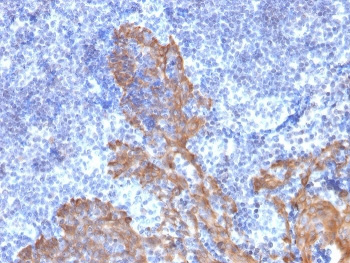- Tel: 858.663.9055
 Email: info@nsjbio.com
Email: info@nsjbio.com
- Tel: 858.663.9055
- Email: info@nsjbio.com
KRT6 Antibody detects keratin 6, a type II intermediate filament protein expressed in stratified epithelia, including skin, oral mucosa, and esophagus. Keratin 6 is typically induced in response to stress, injury, and hyperproliferative conditions, serving as a marker of activated keratinocytes. It partners with keratin 16 and keratin 17 to provide structural integrity during epithelial repair and remodeling.
KRT6 expression is strongly associated with wound healing, psoriasis, and epithelial cancers. Mutations in keratin 6 genes (KRT6A, KRT6B, KRT6C) cause pachyonychia congenita, a rare genetic disorder marked by nail dystrophy and painful keratoderma. The KRT6 Antibody therefore provides a specific and versatile reagent for studying epithelial biology, disease mechanisms, and therapeutic development.
Because keratin 6 is both a stress-inducible protein and a disease-associated marker, Keratin 6 Antibody tools are indispensable in dermatology, oncology, and regenerative medicine.
NSJ Bioreagents offers KRT6 Antibodies validated for immunohistochemistry, western blotting, immunofluorescence, ELISA, and flow cytometry. Each KRT6 Antibody is rigorously tested for specificity to keratin 6 isoforms and minimal cross-reactivity with related keratins.
By selecting a KRT6 Antibody from NSJ Bioreagents, researchers gain reagents optimized for reproducibility and clarity. Our antibodies deliver sharp staining in hyperproliferative epithelium, consistent detection in protein assays, and reliable results across diverse experimental platforms. With detailed datasheets, recommended positive controls, and validated protocols, NSJ Bioreagents ensures that Keratin 6 Antibody products provide dependable performance in both research and diagnostic contexts.
The KRT6 Antibody is widely applied due to keratin 6’s role in epithelial activation and pathology.
KRT6 Antibodies identify keratinocytes activated during wound repair.
The KRT6 Antibody highlights re-epithelialization in cutaneous injury models.
Keratin 6 Antibody tools clarify interactions between keratinocytes and immune cells during healing.
KRT6 Antibodies are used to study pachyonychia congenita caused by keratin 6 mutations.
The KRT6 Antibody detects keratin changes in patient biopsy samples.
Researchers employ Keratin 6 Antibody reagents in genetic models to explore disease mechanisms.
KRT6 Antibodies detect aberrant keratin expression in psoriasis and chronic dermatitis.
The KRT6 Antibody is used to distinguish hyperproliferative epithelium from normal tissue.
Keratin 6 Antibody products support biomarker discovery for inflammatory skin conditions.
KRT6 Antibodies identify keratin expression patterns in squamous cell carcinomas.
The KRT6 Antibody helps differentiate tumor subtypes in pathology panels.
Keratin 6 Antibody reagents are used to evaluate keratin remodeling in metastasis.
KRT6 Antibodies detect epithelial activation in oral mucosa and esophagus.
The KRT6 Antibody supports studies of epithelial turnover in gastrointestinal tissues.
KRT6 Antibodies validate epithelial cell models used in regenerative therapy.
The KRT6 Antibody confirms activation markers in keratinocyte cultures.
KRT6 Antibodies support therapeutic testing for pachyonychia congenita and psoriasis.
The KRT6 Antibody is applied to monitor drug-induced epithelial responses.
Keratin 6 Antibody reagents validate biomarkers in clinical trials for dermatologic therapies.
Keratin 6 plays a central role in epithelial response to stress and disease. The KRT6 Antibody provides a reliable tool to measure these processes, while Keratin 6 Antibody reagents more broadly support discoveries across dermatology, oncology, and regenerative biology.
In wound healing, KRT6 Antibodies highlight keratinocyte activation. In genetic medicine, the KRT6 Antibody clarifies the molecular pathology of pachyonychia congenita. In oncology, Keratin 6 Antibody products help characterize tumor progression and therapy response.
Clinically, keratin 6 markers are used to diagnose and monitor genetic keratinopathies, inflammatory diseases, and carcinomas. The KRT6 Antibody connects laboratory research with diagnostic and therapeutic applications, advancing precision medicine approaches in dermatology and oncology.
Keratin 6 is a stress-inducible protein central to epithelial repair, disease, and cancer biology. The KRT6 Antibody equips researchers and clinicians with a dependable tool for detecting keratin 6 expression, while Keratin 6 Antibody reagents more broadly support advances in skin biology, wound healing, oncology, and translational research. By bridging molecular insights with clinical outcomes, these antibodies remain indispensable for improving biomedical discovery and patient care.

IHC staining of FFPE human tonsil tissue with KRT5/6 antibody (clone KRT5.6/2090).